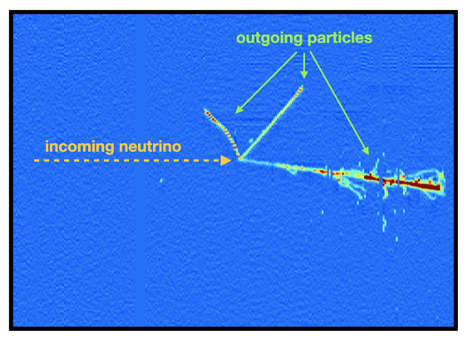The ArgoNeuT collaboration at Fermilab has published measurements of neutrino interactions using new strategies for identifying electron neutrinos. This is a channel critical for future experiments that seek to understand the difference between matter and antimatter in the world of neutrinos.
The international Deep Underground Neutrino Experiment, or DUNE, hosted by Fermilab, will answer one of the biggest open questions in particle physics: How different is the behavior of neutrinos from antineutrinos? The answer rests on our understanding of how electron neutrinos interact in detectors like ArgoNeuT and DUNE across a broad range of energies.
Neutrinos are simultaneously the most abundant particles in the universe and one of the most elusive. One particularly interesting feature that particle physicists study in detail is how frequently each of the three known kinds of neutrinos changes from one type into another as they move through time and space. Think of playing catch with friends: You throw a baseball only to have them catch a softball, or a Wiffle Ball, and you can’t know what they’re going to catch until it’s already in their hands. In this hypothetical game of catch you might ask, if I throw a baseball, how often will they catch a baseball, a softball or a Wiffle Ball? Physicists ask: If I start with a muon neutrino, how often will that muon neutrino be an electron neutrino by the time it interacts in my detector?

An electron neutrino interacts in the ArgoNeuT detector. The incoming neutrino is invisible to the detector until it interacts with an argon nucleus to produce charged particles, which traverse the detector. Image: ArgoNeuT
To answer this question, physicists create beams of one type of neutrino, place a detector some distance away, and then count how many of each type of neutrino are observed by the detector to determine the rate at which each type of neutrino changes into another over that distance. But to accurately count neutrinos, particle physicists first need to understand how to infer the type of neutrino that interacted in a detector.
ArgoNeuT was a small, high-resolution neutrino detector at Fermilab that collected data for six months just over a decade ago. Detectors like ArgoNeuT take high-resolution “pictures” of neutrino interactions. The neutrino itself is nearly invisible to the detector, and most of them pass straight through, never interacting at all. But on the rare occasion that a neutrino interacts with one of the argon atoms in ArgoNeuT, it can create other particles that can be identified. Particle physicists can use information about each particle produced when a neutrino interacts to infer the type and properties of the original neutrino.
The kind and number of particles produced in a neutrino interaction also depends on the energy of the neutrino — neutrinos with more energy tend to produce more particles. Imagine breaking at the start of a game of pool. The harder you hit the white cue ball, the more the other balls will scatter across the table.
One of the biggest challenges in neutrino physics is developing automated algorithms to classify neutrino interactions. Because neutrinos interact so rarely, it can be very hard to sort out the neutrino interactions you’re trying to count from everything else. In fact, among the roughly four million “pictures” collected by the ArgoNeuT detector, only about 100 contain the electron neutrino interactions that were studied in ArgoNeuT’s most recent paper, which presents new strategies for identifying electron neutrinos in detectors like ArgoNeuT.
While muon neutrino interactions with argon have been studied, there remains a lack of data available for understanding electron neutrino interactions, particularly at higher energies. Yet this is exactly the range of neutrino energies that will be most relevant for DUNE, which aims to pin down answers to many of the remaining open questions particle physicists have about neutrinos (and generate new, exciting questions). The strategies developed in ArgoNeuT can be expanded and applied to current and future experiments across a wide range of neutrino energies.
Rory Fitzpatrick and Josh Spitz are University of Michigan physicists. Tingjun Yang is a Fermilab physicist.
The ArgoNeuT experiment is supported by the Department of Energy Office of Science.
Fermilab is supported by the Office of Science of the U.S. Department of Energy. The Office of Science is the single largest supporter of basic research in the physical sciences in the United States and is working to address some of the most pressing challenges of our time. For more information, visit science.energy.gov.



